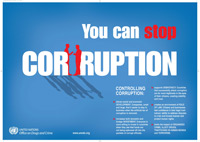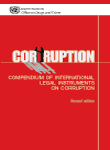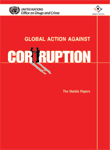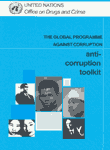 Political party assistance should be a key component of international donors' governance agenda. Efforts to reduce corruption that do not address this domain will be incomplete, as they leave out actors essential to political processes. In this U4 Issue, Thomas Carothers from the Carnegie Endowment for International Peace reviews traditional approaches to supporting political system-building, and points to some new ways in engaging with political parties.
Political party assistance should be a key component of international donors' governance agenda. Efforts to reduce corruption that do not address this domain will be incomplete, as they leave out actors essential to political processes. In this U4 Issue, Thomas Carothers from the Carnegie Endowment for International Peace reviews traditional approaches to supporting political system-building, and points to some new ways in engaging with political parties.
Donwload: International assistance for political party development .pdf
Blogroll
Recent Resource

U4 Anti-Corruption Resources
International assistance for political party development
Labels: Others
Political finance: state control and civil society monitoring
Modern politics face the challenge of reconciling the presence of money in politics with the risks it poses to democratic values and good governance. In this U4 Brief, Bruno W. Speck describes the nature of common risks and challenges, and looks at avenues for mitigating the corruption-related problems with political funding.
Download: Political finance: state control and civil society monitoring .pdf
Labels: Others
Compendium of International Legal Instruments on

The Compendium of International Legal Instruments on Corruption contains all the major relevant international and regional treaties, agreements, resolutions and other instruments. These include both legally binding obligations and some "soft-law"or normative instruments intended to serve as non-binding standards.
Download: Compendium of International Legal Instruments on
corruption.pdf
Labels: Agreements
Global Action Against Corruption. The Mérida Papers

Side events at the High-level Political Conference for the purpose of signing the United Nations Convention against Corruption, organized jointly by the Government of Mexico and the United Nations Office on Drugs and Crime in Merida, Mexico, 9-11 December 2003.
Download: Global Action Against Corruption.pdf
Labels: Papers
Anti-Corruption Toolkit
 The Toolkit is part of a larger package of materials intented to provide information and resource materials for countries developing and implementing anti-corruption strategies at all levels, as well as for other elements of civil society with an interest in combatting corruption.
The Toolkit is part of a larger package of materials intented to provide information and resource materials for countries developing and implementing anti-corruption strategies at all levels, as well as for other elements of civil society with an interest in combatting corruption.
Download: Anti Corruption Toolkit.pdf
Labels: Tool Kit
United Nations Convention against Corruption
The United Nations Convention Against Corruption (UNCAC) creates the opportunity to develop a global language about corruption and a coherent implementation strategy. A multitude of international anti-corruption agreements exist, however their implementation has been uneven and only moderately successful. The UNCAC gives the global community the opportunity to address both of these weaknesses and begin establishing an effective set of benchmarks for effective anti-corruption strategies. The Global Programme against Corruption (GPAC) is a catalyst and a resource to help countries effectively implement the provision of the UN Convention against Corruption.
There are a rapidly growing number of countries that have become parties to the Convention. The primary goal of the Anti-Corruption Unit (ACU)/Global Programme against Corruption (GPAC) is to provide practical assistance and build technical capacity to implement the UNCAC and efforts will concentrate on supporting Member States in the development of anti-corruption policies and institutions. This will include the establishment of preventive anti-corruption frameworks.
Download: United Nations Convention against Corruption.PDFLabels: Convention
Tools to Support Transparency in Local Governance
TI Features: As the product of a partnership between Transparency International (TI) and UN-HABITAT (the United Nations Human Settlements Programme), Tools to Promote Transparency in Local Governance has been developed under the umbrella of the Global Campaign on Urban Governance. It builds on the first toolkit developed by the Campaign to promote good urban governance, Tools to Promote Participatory Urban Decision-Making (PUDM).
To download the PDF click below:
Labels: Tool Kit
10 Myths About Governance and Corruption
Short Description: Back to Basics: Finance & Development, September 2005
Abstract:
Governance—which remains a sensitive and misunderstood topic—is now being given a higher priority in development circles. A few donors and international financial institutions (IFIs) have begun to work with some emerging economies to help reduce corruption, and encourage citizen voice, gender equality, and accountability. When the Group of Eight countries announced in July their decision to double aid and debt relief to the poorest countries in Africa, governance concerns were prominent. And in May, the joint report by the Africa Commission explicitly stated: “Good governance is the key . . . Unless there are improvements in capacity, accountability, and reducing corruption . . . other reforms will have only limited impact.”
But is good governance and controlling corruption really so fundamental for development? The explosion of empirical research over the past decade, coupled with lessons from countries’ own experience, have given us a more solid basis for judging the effect of governance on development, and the effectiveness—or lack thereof—of strategies to improve it. Yet there are still unresolved questions and debates in the development community, not only about the importance of governance, but also about the ability of IFIs to help countries improve on it.
Let us therefore go back to basics and address some prevailing “myths” about governance and corruption.
Content Language: English
Author(s): Daniel Kaufmann
Website (URL): http://www.worldbank.org/wbi/governance
File: Kaufman10 Myths - English.pdf
Number of Pages: 3 p.
Format: application/pdf
Labels: Others
Good Governance versus Bad Corruption
Short Description: Myths & Realities on Governance & Corruption: Implications from Worldwide Evidence
Abstract: This document contains notes/slides with interesting charts and statistics from a presentation made by Daniel Kaufmann, the Director of Global Programs at the World Bank Institute, in July in Nairobi.
Content Language: English
Author(s): Daniel Kaufmann
Website (URL): http://www.worldbank.org/wbi/governance
File: Nairobi_public_lecture_6-06w.pdf
Number of Pages: 41 p.
Format: application/pdf
Keywords: governance, corruption
Labels: Slides
Anti-Corruption NGO Resource Book
NGO Corruption Fighters Resource Book: how NGOs can use monitoring and advocacy to fight corruption.
This subtopic contains the NGO Corruption Fighters' Resource Book by Richard Holloway. The book is designed for NGOs coming from different backgrounds that want to fight corruption. It helps practitioners to understand the anti-corruption context world-wide, and reposition themselves to be most effective - using tested tools of human rights and advocacy organizations. Click on "Resources" above or use the following links to access each chapter:
| Download the entire book in PDF form A resource book designed for NGOs coming from different backgrounds that want to fight corruption. The book helps practitioners to understand the anti-corruption context world-wide, and reposition themselves to be most effective - using tested tools of human rights and advocacy organizations. NGO Corruption Fighters' Resource Book[1].pdf 2.63 MB |
| Chapter 1 - Introduction Rationale for this Resource Book Corruption is a very big problem in many nations of the world – some would assert that it is becoming more extensive, and more areas of development activity are being affected. Corruption is also becoming, de facto, an attack on governance as more and more of the rules under which nations are governed are breached with impunity. Citizen engagement is very important in fighting corruption, and there are particular advantages in getting NGOs more involved in the fight. NGOs have limitations, but also great potential strengths, and these can be better realized through better project management. Chapter ContentsCorruption harms democracy The rise of the anti-corruption movement Enter the NGOs - with strengths, but also limitations Activists and Impact Chapter 1.pdf 67.54 KB |
| Chapter 2 - Monitoring, Advocacy and NGOs in general Defining NGOs, Monitoring, and Advocacy This Chapter looks generally at Monitoring, Advocacy and the NGO. It looks at what NGOs are and what they do (and, by implication, what they are not and what they do not do). It clarifies the nature of Monitoring and Advocacy, the particular strengths these two strategies can bring to anti-corruption work and looks at ways that they can complement each other. Chapters 5, 6, and 7 look at the same three subjects, but take a "how-to" approach, suggesting how they could optimize their work in (respectively) NGO Management, Monitoring and Advocacy. Chapter Contents NGOs - what they are and what they do Three Sectors of the state Figure 1: Three Sectors to the State Specific characteristics of NGOs Characteristics of NGOs that fight corruption The Limitations of NGOs as a tool to fight corruption Possible Corruption in NGOs themselves
Monitoring – what it is and what it does Introduction NGO Monitoring The Targets of Monitoring Key Activities in Monitoring Testing the Rhetoric and Finding where the Real Problem is Monitoring Investigates the Functioning of Systems Monitoring Checks Compliance with International Standards Monitoring is a Tool that Needs Access to Information Stakeholders Monitoring is a Tool that is Valuable in Itself, but is made more Effective when joined with Public Information and Advocacy.
Advocacy – what it is and what it does Introduction NGO Advocacy The Issue for an Advocacy Campaign Key approaches in Advocacy Advocacy requires Appropriate Targets Advocacy requires Coalitions Learning to use the Political Environment Most Good Advocacy involves the Media Gathering and Disseminating Relevant Information Organised Actions Advocacy needs Competent NGOs and is built on Good Monitoring
Annex 2/1: Schematic of Civil Society Organisations and the State Chapter 2.pdf 248.55 KB |
| Chapter 3 - A Closer Look at Corruption An overview of the key debates about corruption In order to engage in the struggle against corruption, an NGO should have an overview of the key debates about corruption, as well as an assessment of corruption in his/her country. Such an overview will not only provide information about possible causes and remedies, but also help prioritize intermediate goals based on areas of greatest need in the particular society, as well as the resources and allies that may be involved in the process. Chapter Contents Administrative or Petty Corruption Grand Corruption State Capture Links between Government and Business Assessing Corruption Surveys National Corruption Surveys Governance Assessments 1 Governance Assessments 2 Check lists Journalistic Pieces Citizens Report Cards Chapter 3.pdf 179.49 KB |
Chapter 4 - Kinds of Anti-corruption Activities Approaches used to fight corruption Chapter 4 examines the range of possible anti-corruption activities - looking at a variety of approaches and their conceptual bases. It covers a variety of strategies – particularly focussing on those involving citizens. It points out the very great importance of identifying "clean" people to be your allies, and emphasises that the choice of strategies must be informed by local realities (attitudes, history, governance systems, and power structures). It shows that there is no easy answer to corruption, and certainly that no "one size" fits all situations. NGOs need to work pragmatically within local realities. Chapter Contents The “Criminal Control” Approach The “Small Government” Approach Incentive Based Approaches The “Political Economy” Approach “Integrity Based” Approaches The Need for a Variety of Strategies The Anti-Corruption Players The Role of Government The Role of the Private Sector The Role of the International and Inter-governmental Organisations The Role of Civil Society Political Will Physical Danger Chapter 4.pdf 139.46 KB |
| Chapter 5 - How Ready is Your NGO to Implement Anti-Corruption Programs? NGO qualities necessary for effective anti-corruption work Chapter 5 looks at the qualities that an NGO needs to have if it wants to engage in effective anti-corruption work, particularly whether it can clearly define anti-corruption objectives that it has a chance of achieving. It looks at the capacities than an individual NGO needs in terms of credibility, reputation, and risk management. It then looks at general organisational competence necessary for NGOs that are prepared for the long fight to defeat corruption, and their ability to set realistic and achievable objectives. It provides exercises and self-learning tools for NGOs to identify their strengths and weaknesses, and ways to build their capacity in areas where they are weak. Finally it introduces a scenario based on the imaginary region of Agraria in the country of Agronomia to try these ideas out. Chapter Contents Clarifying the Identity of the NGO The Basis of the NGO’s Mandate How the NGO is Perceived Clarifying who is on the side of the NGO How the NGO is placed if things get dirty How the NGO handles personal risks Self-Assessment Brutal Honesty Setting Objectives (Agraria scenario) Stakeholder Analysis Problem Identification Problem Tree Objectives Tree Analysis of Alternative Strategies Making a Logframe Hierarchy of Objectives Assumptions/Risks Indicators of Success/Means of verification Figure 2: Log frame for Agraria Workplanning Figure 3: Workplan for Agraria Summing Up
Annex 5/1: Legitimacy Check list Annex 5/2 Characteristics of NGOs at different stages Annex 5/3 How to use the OCAT for NGOs Annex 5/4 General Organisational Capacity Assessment Tool (OCAT) Chapter 5.pdf 650.42 KB |
| Chapter 6 - How Best to Fight Corruption through Monitoring A "How-to" approach to monitoring Chapter Contents Chapter 6.pdf 268.44 KB |
| Chapter 7 - How Best to Fight Corruption through Advocacy A "How-to" approach to advocacy Chapter 7 is for those who have decided that they are ready to use the advocacy tool to fight corruption, and discusses what aspect of the situation they may want to change (laws, policies, practices or behaviour – or more than one of them). It points out the criteria for an advocacy campaign, how you can identify the target both primary and secondary for your advocacy initiative, and how you might go about building alliances and networks. It talks of the need to understand the formal policy making apparatus and the key stakeholders involved in them, the role of organised action, formulating messages and using the media, the particular skills that are needed for advocacy work, how to formulate an advocacy strategy and plan, and finishes with preparing an advocacy plan for Agraria. Chapter Contents Getting Ready for Advocacy Advocacy for Laws, Policies, Practices, and Behaviour Criteria for an Advocacy Campaign Identifying the Target Primary and Secondary Targets Building alliances, coalitions and networks Laws, Policies, and Key Stakeholders in developing them Figure 9: Stakeholders in the Policy Process Tools for Analyzing Policies and Stakeholders Figure 10: Policy System Overview Map Figure 11: Policy System Close Up Map Organised Action Formulating Messages and Using the Media Skills Needed for Advocacy Work Elements of an Advocacy Strategy Other Kinds of Advocacy Agraria Scenario: Constructing an Advocacy Program for Agraria
Annex 7/1: 10 Elements of an Advocacy Strategy and their linked questions Annex 7/2: 198 Non-Violent Ways to Bring about Change Annex 7/3: Three worksheets for Advocacy Campaign Planning Chapter 7.pdf 334.6 KB |
|
| Chapter 9 - Case Studies Case studies in anti-corruption efforts This chapter contains the following nine case studies:
1 PSAM (Public Service Accountability Monitor), South Africa The Case Monitoring Project—monitoring, documenting, and investigating cases of misconduct, corruption and maladministration in the government of the Eastern Cape Province
2. TI (Transparency International) Slovakia Monitoring of the Privatization of Slovak Telecom
3. Open Society Georgia Foundation in Georgia Civil Monitoring of the Presidential Decree #95 of 15 March 2001
4. Global Witness, UK Independent Observer in Support of Forest Law Enforcement in Cameroon
5. Center for the Implementation of Public Policies Promoting Equality and Growth (CIPPEC), Argentina Argentina‘s Budget Watchdog: "Lupa Fiscal"
6. Poder Ciudadano, Argentina The Program for Transparent Contracting
7. Mazdoor Kisan Shakti Sangathan (MKSS), Rajasthan, India Jansuvai Public Hearings and Right to Information Campaign
8. Uganda Debt Network (UDN), Uganda Monitoring of Poverty Action Fund (PAF)
9. People’s Movement "Resistance," (OTPOR!) Serbia Customs Monitoring Chapter 9.pdf 254.9 KB |
Labels: Ebook
Business Without Corruption: An Action Guide
An anti-corruption handbook. This brochure is the result of a joint effort by two nonprofit organizations that are wellknown to businesspeople: OPORA and INDEM. The INDEM Fund is known for its research on corruption.
Perface This brochure is the result of a joint effort by two nonprofit organizations that are wellknown to businesspeople: OPORA and INDEM. The INDEM Fund is known for its research on corruption. For the last three years it has been involved in projects to study small business. OPORA is well-known as a business association not only for its research, but also for its extensive practical work to improve the business climate. The authors of this brochure faced a complex task: To give small business owners tools to resist corruption and strategies to survive and grow in an extremely aggressive environment. These strategies are not easy to use, because they are often in tension with your previous experience. They involve rejecting the corrupt ways of doing business. Our suggestions are based on the results of research, an analysis of positive experience (however limited), and extensive interviews with representatives of small and mediumsized businesses throughout the country. Our analysis of the situation and proposals are accompanied by specific examples and quotations from anonymous interviews with businesspeople. We do not see this text as the final truth. On the contrary, we hope this brochure will be the starting point of a discussion with active participation by its readers. This will help us correct mistakes and inaccuracies and gather additional information. With your help, we will then update the text with a new level of understanding.
Website (URL): http://www.cipe.org
Author(s): Georgiy Satarov and Sergey Parkhomenko from INDEM, Dina Krylova, OPORA; and Yuliya Rostovikova, Novorossiysk Chamber of Commerce and IndustryDownload: business without corruption action guide.pdf 182.57 KB
Labels: Handbook
